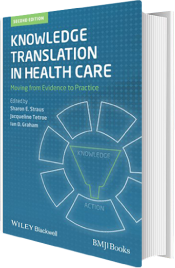Samir Gupta, MD, MSc, FRCPC
Ann McKibbon, BSc, MLS, PhD
Download: Presentation (PDF, 190KB)
Topic Focus
- Introduction
-
Role of Informatics Interventions in KT:
- Education
- Reminder systems
- Clinical decision support systems
- Presenting and summarizing data
- Areas of future research
- Summary
Introduction
-
Knowledge translation (KT) consists of:
- Collection
- Summarization
- Packaging
- Delivery
Of (research) knowledge
-
Informatics interventions:
- Same concepts, but for information
- These are natural partners in health care enhancement
How Informatics Can Enhance KT
-
Education:
- online interactive education, individually tailored education
-
Reminders:
- lessen “cognitive load” on clinicians
-
Summarizing and presenting data:
- useful, timely, variety of formats
-
Computerized decision support systems:
- support clinician decision making
Education
- Web-based continuing education and patient education: evidence on effectiveness lacking or at best shows weak positive effects
- Problem: static, one-size-fits-all educational modalities are ineffective
- Individualized education based on needs assessment → more learning
- Informatics interventions can improve learning by providing tailored, “as-needed” content
Reminder Systems
- Reminder systems can reduce the cognitive load for clinicians
-
Computers:
- Efficiently check data against clinical rules
- Provide prompts for patient and provider adherence (e.g. screening tests, drug interactions, etc.)
- Reminder systems free clinicians to concentrate on the needs of each individual patient rather than sorting and processing data
- Patient reminder systems promote self-directed care and hold promise as well
Summarizing and Presenting Data
- Computers can store, synthesize, and present data in a user-friendly format
-
Can be used for:
- online medical education
- delivering knowledge embedded within information systems
- individualization: tagging specifications for guidelines can match their content to individual patients in electronic medical records systems (EMRs)
- Hospital clinicians can use handheld computers for a similar point-of-care function
- Patients may also use electronic self-management tools directly to present data to physicians in real-time
Clinical Decision Support Systems
- Providers require “just-in-time” knowledge
-
CDSSs:
- match patient data to a computerized knowledge database
- use software algorithms to generate patient-specific recommendations
- address diagnostic, prevention or screening, drug dosing, or chronic disease management decisions
- Systematic review of the effectiveness of CDSSs: Garg, et al. reported improved practitioner performance in most studies
Patient Decision Aids
- Computerized decision aids are a type of CDSS that targets patients
- Present patients with evidence-based information about personally relevant options and outcomes
- Enable patients to participate in their own health care decisions
Future Research
- Needs to broaden the scope of KT informatics interventions
-
Will require:
- improved technology (e.g. improving information standards and enhancing system interoperability)
- social sciences (understanding individual needs and characteristics → design easy-to-use interventions
- business (managing system change with financial integrity)
- decision makers, health care providers, and patients
- Personal health records: area of potential – requires qualitative and quantitative interdisciplinary research
- Future research must also address the effects of informatics and KT interventions on patient and wellness outcomes
Summary
- Many informatics applications can be effective KT tools, delivering evidence to professionals and patients
-
Informatics interventions that speed KT can be found in:
- patient and physician education
- reminder systems
- systems to summarize and present data
- decision support
- These improve education, improve adherence through reminders, collect and present data from multiple sources, and support decision making
- Effects on health outcomes are less well demonstrated
- We have yet to harness the full potential of integration of the KT process with informatics applications

